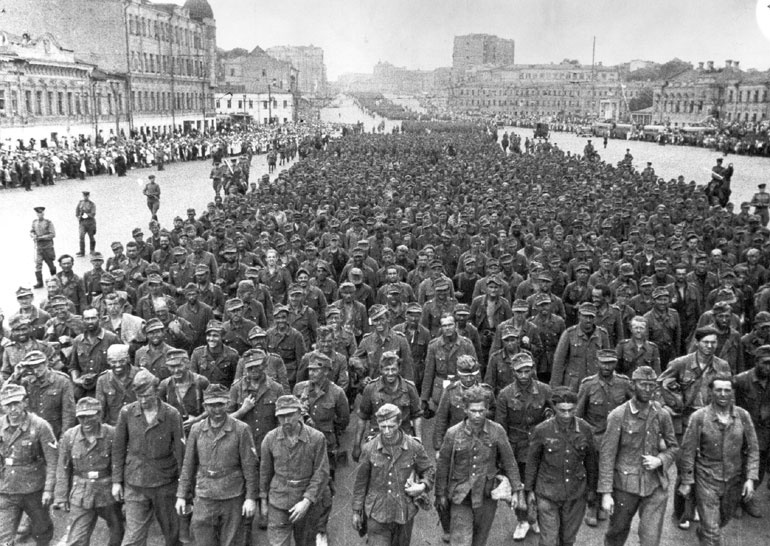57,000 German prisoners march to Moscow after defeat at Belarus during “Operation Bagration”, 17 July 1944.
Operation Bagration – the Soviet destruction of German Army Group Center – was, arguably, the single most successful military action of the entire war. This vital Soviet offensive was launched just after Allied troops had landed in Normandy, and it is symptomatic of the lack of public knowledge about the war in the East that whilst almost everyone has heard of D-Day, few people other than specialist historians know much about Operation Bagration. Yet the sheer size of Bagration dwarfs that of D-Day. Operation Bagration (named after a Georgian hero in the war against Napoleon 130 years earlier) was not just one of the largest military offensives of the war, it was one of the most sophisticated. On 19 June 1944, Red Army partisan units, operating behind German lines, attacked transport and other Wehrmacht supply lines; two days later the Soviets launched massive air attacks; and then on the 23rd (one day after the third anniversary of the German invasion) the Red Army moved forward under cover of darkness.
Their advance caught the Germans by surprise. Once again, the Soviet technique of ‘maskirovka’ (deception) had worked. The Soviets pushed forward in powerful spearheads leaving enemy units isolated behind them – a tactic that was made all the more effective because of a tactically disastrous decision Hitler had made. The German leader had ordered the soldiers of Army Group Center to stand firm and inflexible in the face of any Soviet advance. His directive of 8 March 1944 had announced that ‘feste Plaetze’ (fortified places) should be the core of the German defense. The idea was that the Soviets would advance past these fortifications, which would, Hitler said, “fulfill the function of fortresses in former historical times”. The commander of the German Ninth Army, General Jordan could scarcely believe the nature of the order he had been given..
.jpg)
57,000 German prisoners march to Moscow after defeat at Belarus during “Operation Bagration”, 17 July 1944
.jpg)
German prisoners, 17 July 1944
German prisoners, 17 July 1944
“Ninth Army stands on the eve of another great battle”, he wrote, “unpredictable in extent and duration the Army believes that, even under the present conditions, it would be possible to stop the enemy offensive, but not under the present directives which require an absolutely rigid defense”. “Hitler’s orders to hold firm were totally disastrous”, confirms Antony Beevor. “He refused to allow his generals any flexibility or leeway which was totally contrary to all the precepts and the teaching of the German general staff… but because Hitler so distrusted his generals he wanted to control everything and that was basically the undoing of the German army”. “The German behavior in their fortified areas was stupid”, says Veniamin Fyodorov, who participated in the initial Soviet assault in Operation Bagration. “Our shelling broke them down. Huge amounts of shells flew towards them and you couldn’t hear anything: only this booming! The fortified areas could be smashed completely. It was death… The Germans held the ground to the last man – they were all doomed to death”
.jpg)
German prisoners, 17 July 1944
.jpg)
German prisoners, 17 July 1944
.jpg)
German prisoners, 17 July 1944

.jpg)